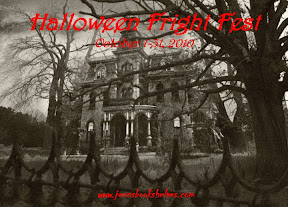Earlier in the month, I was chatting on Twitter (of course!) about the differences between thrillers & horror. I was interested in writing a post discerning the two, and Carrie (also known as @inkedhistorian on Twitter. willingly obliged. Carrie blogs about books at The Books I Read. Here’s a bit about Carrie:
Speculative fiction writer, art historian specializing in early American books and prints, and amiable raconteur.Reads, cooks, takes pictures and gets tattoos in her spare time.Married to a mad scientist, mother to a rock star.
What Makes A Thriller?
To describe a story or novel as being a thriller means to relegate it to a category of writing that is overwhelmed with expectation. A “good” thriller meets these expectations, while a “bad” thriller does not. Somewhere near the beginning, we need to be introduced to a main character who will be our avatar for the story. For the purposes of this example, we’ll pick an accountant from upstate New York, and we’ll call him Jack. Jack will live through the whole story, and possibly even through the ending, though that remains to be seen. It will be Jack’s story that we’re reading, and Jack who we identify with. In caring about Jack, in eventually fearing for his safety, we will expose those emotions in our own chests, and the book will rub them raw.
Which is the point of reading a thriller, anyway.
But let’s get back to Jack. Perhaps we meet him at the funeral for his wife, or a friend, or the family dog. Perhaps he’s been fired under mysterious circumstances, or his car’s tires have been slashed. These events, when they happen in the first chapter of the book, tell us that something bad is already after Jack, and gives us insight into his predicament that he himself probably doesn’t have yet. Depending on the author, the bad thing hiding in the shadows of Jack’s life hasn’t noticed him when the tale begins. We might get to see his life the way it was before all the pain and terror and loss begins to rain down upon him like snow falls during a New England winter storm. His happy life, then, will be shown as safe and cozy, in a comfortably lived-in house with a warm fireplace and double-paned windows insulating his perfect family and their lovely afghan (because you know that these winter scenes always include a couch that no one sits on decorated, with an afghan that no one uses, probably crocheted by a lonely aunt).
One day, that will change for Jack – one day he’ll cut someone off in traffic, who will then blame Jack for their lateness to a crucial job interview, and because they didn’t get the job, the loss of their already disaffected wife. Maybe it isn’t even Jack’s actions which begin the bad things soon to happen to him; out in the shadows, Jack’s daughter has a new boyfriend she doesn’t want to bring home. The daughter will be a little afraid of this boy, and use her father as an excuse to break things off with him, and Jack will spend 18 chapters trying to figure out why someone he has never met wants to set his afghan on fire.
Poor afghan. Poor Jack.
A thriller is a story where a basically innocent person endures increasingly terrible events until they can’t take it anymore, and in a fit of fight-or-flight syndrome, they choose to run. The dark and disturbing pieces of Jack’s life swirl around him (and us, the readers) in an external way, while his heart races and his fear grows and he loses sleep and we feel his panic setting in. One day, he can’t take it any more, and he rabbits, grabbing the wife and the daughter and the family station wagon and heading for his family cabin in the woods, which surely the bastard ex-boyfriend won’t know about. Will he? Probably not. At the cabin, Jack will be safe, certainly, and by the time the family arrives there we should be about 2/3 of the way through the story, and in dire need of an emotional break. We need a happy scene to brighten our spirits, and to remind us again that Jack still has something to lose.
Let’s give Jack the day off. Let him take the daughter fishing, roast s’mores over a campfire, tuck the daughter into bed (under the afghan, which finally has a use, and is feeling pretty pleased with itself at that moment), and then, finally, let Jack make gentle and only slightly awkward love to his wife. Let them all go to sleep, finally safe, finally alone.
It’s just one day, and we can give it to him.
He’ll need it to be refreshed for what comes next: the climatic ending. A thriller always have to have one, and Jack’s in for a surprise when he wakes the next morning to find his daughter gone. Thinking that maybe she went for a walk – perhaps the romp with the wife tired Jack out a bit more than usual, and he overslept – Jack goes outside to find a tiny scrap of brightly colored acrylic yarn resting gently on the dew-moistened grass. It’s a bit of his aunt’s afghan, the one which last covered his sleeping child …
Oh dear.
Whatever happens next, Jack’s going to go through something life-changing. If he survives, he’ll probably have to choose between his daughter’s life and his wife’s, or endure a cat-and-mouse game of terror, running through the woods at night without a flashlight while the ex-boyfriend chases after him. The boy has youth on his side, and insanity-fueled adrenaline, and Jack will be regretting letting his gym membership lapse. Escaping this madness will give Jack a better understanding of how precious his life is, and he’ll be a stronger man for it, at the end of the book. It’s just as likely that he and his whole family will die, and leave someone else to finish telling his story, one that won’t be completely revealed until the last page. We’ll read it, and fall back spent, being both awed at the author’s ability to drag us along for Jack’s hellish ride, and at our own realization of how precious our lives really are.
A thriller exposes your fears to you by showing them reflected on a fictional character’s life, so we can experience them in a safely controlled environment – after all, you can put the book down whenever you want to. It’s fear in small doses, in manageable amounts. It’s a roller-coaster ride that you control. Knowing this, we can appreciate a thriller for what it is and what it gives us. We’ll go to bed, happily snuggled up under the brightly-colored afghan we found at that yard sale last month, the one with the tiny piece missing from the corner, and we won’t think twice about how Jack’s own afghan was never found …
Thank you, Carrie! Please check back later for my post about the definition of horror.







Pingback: What Makes A Thriller? « Writing about Writing